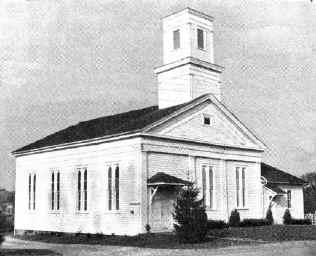|
Mercer County PAGenWeb |
| Clarksville | |||||||
Clarksville Methodist Church |
|||||||
The structure built in 1830 was finally sold for a machine shop, and a frame structure costing $2,000 was erected in 1858 on the church's present (1959) site. William Budd and John Patterson of Sharon were the contractors. Abraham Clark was the last
survivor of the original members of the first class, having reached the
age of eighty-eight years on the 21st May, 1888. In his possession was
the class book of 1821, which contained some very interesting
information. At that time William Swayze was the
presiding elder, and Charles Elliott, Dennis
Gladden and John Crawford were preachers in
charge. “I have before me the ‘class papers’ of Clarksville appointment from 1821 to 1836. From 1833 the title ‘class book’ came into use. These ‘class papers’ were made up by the preacher, by folding one or two large sheets of paper, forming sixteen or thirty-two pages of the size of those of our Discipline. The pages are ruled for names and dates, and squares for marking attendance. Sometimes the sheets are not folded in book form. Attendance is carefully marked, and the average is perhaps a little above one-half the membership. Cases of expulsion are not infrequent. On the first page are the names of the presiding elder, circuit preacher, class-leader—and sometimes ‘assistant’—and some words of exhortation; as, for instance, on the first ‘class paper’ is written ‘Watch and pray. Remember the quarterly fast’; on the second page, ‘Every Friday preceding each quarterly meeting is to be kept as a day of fasting and prayer for the prosperity of Zion. Watch much, pray much, mark your paper, and keep it clean.’ “Samuel Clark was
the class-leader until 1833, when we find also the name of
Samuel ‘Campfield’—the class having been divided; and in 1835 that
of William G. McKnight. On the last page of the first ‘class
paper,’ 1821, we read: Blessed are the dead which die in the Lord from
henceforth; yea, saith the Spirit, that they may rest from their
labors; and their works do follow them.’ Sometimes the usual first page
writing is transferred to the last page—on this page of the ‘class
paper’ for 1827-8 we read: ‘Watch and pray. Pray for us brethren. Love
one another.’ The society continued to
prosper and in 1899 the church building was altered to meet the growing
needs of both Sunday School and Church. During the pastorate
of Rev. John Snyder in 1953 the congregation purchased and
installed an electric organ. Later the interior of the church was
renovated and the Sanctuary redecorated. The parsonage was not
overlooked or forgotten and at this writing (1959) the church and
parsonage are in excellent condition and the congregation free of
debt. (Source: 150 Years of Methodism, The Story of the First Methodist Church, Sharon, PA, compiled by Roscoe C. Wilson, 1959)
|
|||||||
Return to Churches Home Page
Return to Mercer County Home Page
